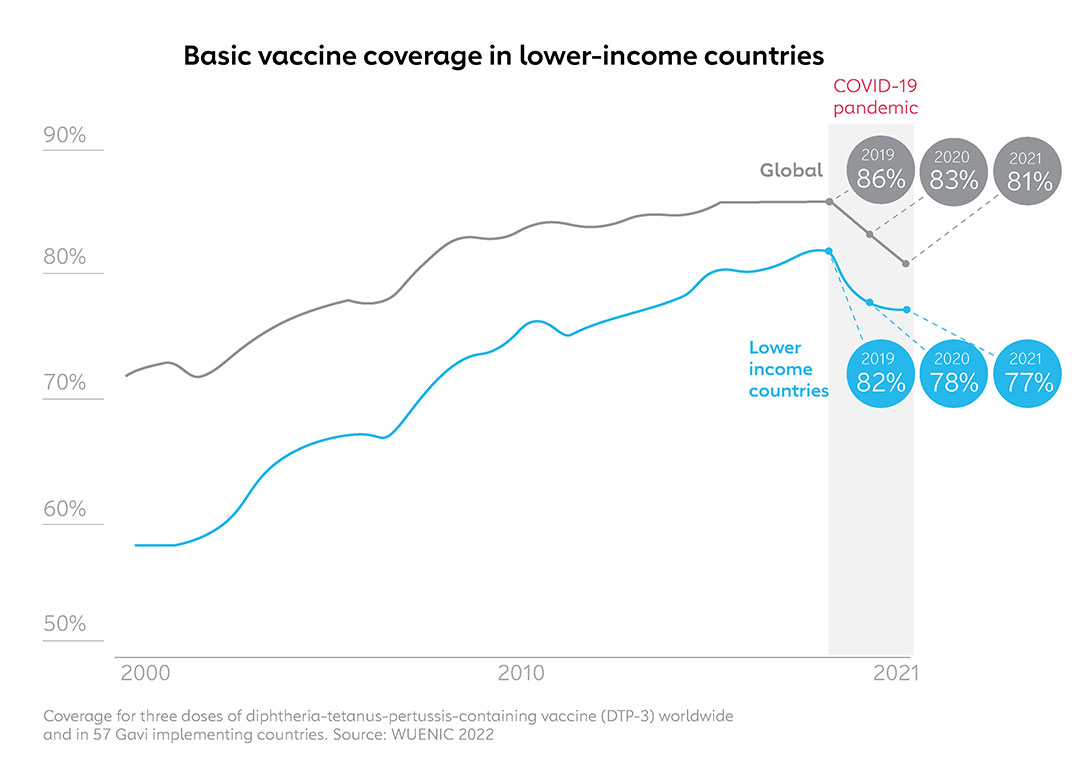Children in rich countries increasingly miss out on lifesaving vaccines
Fewer vaccines against diseases like measles, rubella and polio are being given to children in the UK, as numbers continue to fall year on year.
- 6 October 2022
- 3 min read
- by Priya Joi

Vaccination coverage for UK children under five has fallen, data for 2021-2022 shows, putting thousands more children at risk of deadly childhood diseases such as measles.
Not one of the 14 routine immunisations given met the 95% coverage target set by the World Health Organization (WHO), according to statistics from the UK Health Security Agency (UKHSA) and NHS Digital.
Data from the US Centers for Disease Control and Prevention shows a similar picture in the US, where the national childhood vaccination rate fell by 1%, from 95% in 2019 to 94% in 2021.
Falling immunisation rates allow infectious diseases, such as measles, to circulate within communities and can infect people who have extremely lowered immunity, such as people with cancer or babies who are too young to be vaccinated.
Earlier this year, data from WHO and UNICEF showed how worldwide the pandemic had driven the largest drop in childhood vaccinations in 30 years, with low- and middle-income countries especially affected. But as this new UK data indicates, it is not just less well-resourced countries that are seeing greater numbers of children vulnerable to killer diseases that are preventable by vaccines.
Have you read?
Worldwide declines
In July 2022, a Gavi analysis of routine immunisation in 57 lower-income countries showed that basic vaccine coverage dropped from 86% in 2019 and 78% in 2020 to 77% in 2021. India, for example, saw its relatively high coverage level of 91% drop to 85% in 2021. Globally, coverage was slightly better but it had still fallen from 86% in 2019 to 81% in 2021.

In 2021, the number of zero-dose children, who have not received a single shot of basic vaccines, rose for the second year running to 12.5 million. Some countries such as Chad and Niger did manage to buck the trend, and both increased coverage across the pandemic period from 2019-2021, reducing the number of zero-dose children by 16% and 20% respectively. Pakistan too, although it had seen its immunisation drop drastically in 2020 at 77%, compared with 84% in 2019, managed an impressive recovery of vaccination rates to pre-pandemic levels, rising to 83% in 2021.
Risky future
In the UK, immunisation coverage has been falling for a few years now. In 2022 coverage of the first dose of the measles, mumps, and rubella (MMR) vaccine was just 89.2% in children aged 24 months, down from 90.3% the previous year. Coverage for the second dose of MMR by age five was down by nearly 1%.
Falling immunisation rates allow infectious diseases, such as measles, to circulate within communities and can infect people who have extremely lowered immunity, such as people with cancer or babies who are too young to be vaccinated. Moreover, vigilance is needed even with diseases that have seemingly disappeared from countries like the UK. Earlier this year, health officials were alarmed to discover polio samples in London sewers and it sparked a polio vaccination campaign.
While disruption from the pandemic is one likely reason for falling rates, Helen Bedford, immunisation expert at the Royal College of Paediatrics and Child Health, told the British Medical Journal health agencies must act now to “commission research into strategies to tackle vaccine hesitancy and tailoring interventions appropriately”.








